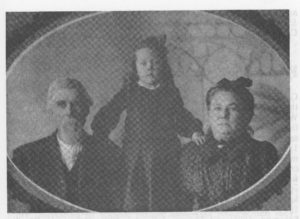Thomas Jefferson Mullins was born in 1816 on a farm in Rockingham County, North Carolina. In 1836, T.J. married Matilda Mims in her home county, Caswell County, North Carolina (adjacent to Rockingham County)1. The history of the Mims family is detailed in Matilda’s biography. T.J. began tobacco farming in Caswell County, and had three children while the couple lived there. In the spring of 1842, the family moved to Rockingham County, where two sons were born, including the next in the Mullins lineage, William Madison Mullins (1845-1913)2.

Inez Seignor Mullins (r.)
& Theodocia Virginia (Stearns) Mullins
In 1846, T.J. Mullins and his family began a long westward migration2. The migration of tobacco farmers at that time occurred for at least three reasons. For one, families tended to have many children, as T.J.’s father and grandfather did. Some children would inherit part of the family farm, but others would need to move on to find new areas of opportunity. Second, tobacco farming wore out the soil fairly quickly. The T.J. Mullins family would move their farm five times over the next 45 years. Third, given the prevalence of diseases such as Cholera that were related to the inevitable poor sanitation of the era, families favored moves every few years to pristine, unpolluted farmland and forest.
In April 1846 the T.J. Mullins family sold their Rockingham County farm, packed up their 5 children including the next in this Mullins lineage, William Madison Mullins, just 6 months old at the time, loaded everything on two wagons drawn by mules, and a two seat carriage drawn by two horses, and moved 500 miles almost due west, to McNair County, in western Tennessee, where T.J.’s young uncle Samued Mullins had settled. T.J. established a successful new tobacco farm in McNairy County2,3, and 2 daughters were born there.
Six years later, in spring 1852, the family sold that farm, and again moved 300 miles west to Christian County in southwest Missouri. We have evidence that relatives of Matilda Mims lived in Christian County, MO, by the name of Holcombe, which could be the reason the family chose to move there. The Mims, Holcombe and Mullins family share ancestry from the Woodson family. Two more daughters were born in Missouri, and T.J. Mullins established a prosperous tobacco and manufacturing operation once again2,4.
The family’s migration is well documented by U.S. Census records, showing them living and farming tobacco in Rockingham County, NC, in 1840, McNairy County, TN, in 1850, and Christian County, MO, in 1860. T.J.’s final move was to Fayetteville, Arkansas, just after the Civil War.
The most interesting connection regards the move to Fayetteville after the Civil War. On September 7, 1866, T.J. Mullins purchased 80 acres of farmland from Edward Freyschlag for $6002. It turns out that Edward’s wife, Lucy Hawkins Freyschlag, was a distant relative of Matilda Mims, again through the Woodson family. We do not know if the Freyschlags and the Mullins’s knew of this connection, or how the Mullins’s came to purchase land beside the Freyschlags. In any case, a result of the move was that William Madison Mullins and Sophia Freyschlag, met as next-door neighbors, and married 5 years later, in 1871.
It also remains an open question why William Mullins and Sophia Freyschlag took five years to decide to marry. Did they know that they were distant relatives? She was said to be “the beauty” of the Freyschlag children5,6. It is interesting that William Mullins was the only family member who had fought on the Union side during the Civil War. Sophia’s father, Edward, was a Confederate soldier, as were William’s 3 older brothers; further, Sophia’s young uncle, Martin Hawkins, lost his life early in the war, fighting with the Confederates at the Battle of Wilson’s Creek in Missouri. One could imagine a conversation between Sophia and her mother, Lucy Hawkins Freyschlag, starting with Lucy: “What about that nice young man next door, Will Mullins?” Sophia: “Ma, I ain’t marrying any damn Yankee soldier, so just forget it!” But this is complete speculation. It is just as likely that she admired his courage in joining the Union Army when others in his family had served with the Confederacy. The true story of their courtship awaits discovery of contemporaneous letters or journals.
The proof of Thomas Jefferson Mullins’s lineage is detailed in his grandfather’s biography, Rev. Thomas Mullins.
© 2013 W. Mullins
